(Upload on December 16 2025) [ 日本語 | English ]
Mount Usu / Sarobetsu post-mined peatland
From left: Crater basin in 1986 and 2006. Cottongrass / Daylily
HOME > Lecture catalog / Research summary > Glossary > Plant morphology
Brief history1672 Grew, 1675 Malpighi: anatomyGoethe, JW von, literary figure 1790 Metamorphase der Pflanzen (plant metamorphosis 植物変態論)
comparsions of plant organs → metamorphosis → morphology 1817: Zür Morphologie: firstly used the term morphology 1827 de Candolle: Organographie (器官学)⇒ due to development of microscope 1868 Sachs, 1877 de Barg: Plant anatomy (植物解剖学) developmental morphology (or anatomy) (発生解剖学) 1877 de Bary, Heinrich Anton (1831-1888)plant tissue observations (≈ plant anatomy)
flower → sexual cell |
Vascular plantorgans = stems + leaves + roots (shoot = stem + leaves)+ flowers (specialization of shoots) Seed plantDef. petal (花弁): a small piece located between the sepals and stamens
often large, petaloides, conspicuous and/or colorful
Reduced-petaled flower (退化花弁花): traces of degenerated petals, e.g., Asarum
Sympetalous flower (合弁花): petals fused together Techniques
|
 Flower = reproductive organ for seed plants → producing seeds
Angiospermae → flower (s.s.) 1912 Potonie, 1914 Lignier, 1916 Bower, 1917 Kidston & Lang: The most simple organization of vascular plant = furcate |
1930 Zimmermann: proposed Telome theory based on Rhynia (middle of Devon, small teresstrial fern discovered from Scotland → telome = gymnosporangia on the apex → adhesion → seed coat or testa (hypothesis) 1948 Lam, 1960-63 Melville, 1966 Meeuse: proposed a hypothesis on flower structure based on Telome theory → new morphology 1961 Eames: A determinate stem tip bearing sporophylls and, commonly, other appendages that are sterile 1980 Bold: It is the reproductive organ of seed plants. The top of spur shoot becomes remarkably short, and it forms the receptacle. The flower is regarded as specialized shoot with the specialized organ of floral leaf |
Position of flower on stemterminal flower (頂生花), e.g., tulipaxillary flower (腋花), e.g., mint, Kummerowia striata (Thunb.) Schindl. Perianth (花被)= perigonium, perigon or perigonethe sterile parts of a flower = sepals + petals (花弁) or tepals (花被片)
Sepal (萼片): one of the modified leaves comprising a calyx Tepal (花被片)outer tepal (外花被片)innter tepal (内花被片) |
Peduncle (花柄)the stalk bearing a flower or fruit or the main stalk of an inflorescencePedicel (小花柄): a small stalk bearing an individual flower in an inflorescence Chasmogamous and cleistogamous flower (開放花と閉鎖花)Chasmogamous flower or chasmogamic flower (開放花): open petals encircling exposed reproductive parts, usually we see this ordinary flowerCleistogamous flower or cleistogamic flower (閉鎖花): not open petals but are self-pollinated - reproducing during a period less favorable for the usual blossoms or chasmogamous flowers Ex. Viola spp. (e.g., Viola verecunda), Impatiens noli-tangere, Chloranthus serratus |
|
pollen-producing organ on a flower = anther + filament Androphore: a column formed from the fusion of multiple filaments 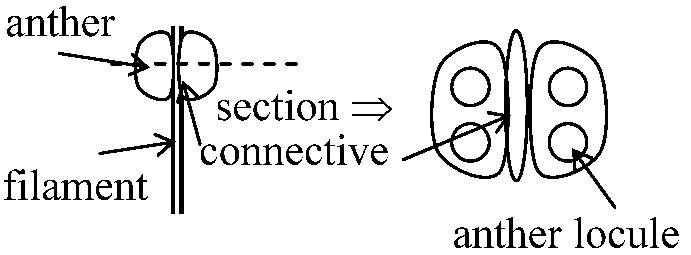 anther (葯): the part of a flower that contains pollen
bear (pp. borne): 位置する ascending 上向き ↔ descending 下向き extrorse 外向き ↔ introrse 内向きの
introrse: facing or turned inwards or towards an axis - promoting self pollination filament (花糸): the stalk of a stamen, bearing the anther at its apex anther locule (葯室) = microsporangium, connective (葯隔) Nectary (蜜腺)Secretory apparatus of nectar - internal floral nectary = most of them on the base of flowersStamen origin No vascular bundle
Pollen (花粉)a fine to coarse powdery substance, produced by the male part of a flower, comprising pollen grains |
Pollen grain (花粉粒)each pollen grain contains vegetative cells (a single cell in most species) and a reproductive cellmicrospore → division → pollen grain Dispersal unit:__Vesiculate/saccate_________________________________Pollinium  Monad____________Dyad__________Tetrad______Polyad Size: < between 10μm and > 200 μm Wind pollinated, airborne pollen grains normally range from 10 μm to 80 μm Shape (aspect ratio): determined by ratio between the length of the polar axis and the equatorial diameterStructure (aperture): 
mono-, di-, tri-, tetra-, penta-, hexa-, poly- (> 6) + porate, colporate, coporoidate |
|
A discrete organ in the center of a flower capable of receiving pollen and producing a fruit = ovary (子房) + style (花柱) + stigma (柱頭)
Stigma: uppermost part of the pistil - pollen-receiving surface Placenta (胎座)an organ formed by the sustained apposition or fusion of fetal membranes and parental tissue for physiological exchangePlacentation (胎座配列)1) Parietal (and marginal) placentation (側膜胎座) 2) Axial placentation (axially or axile) (中軸胎座) 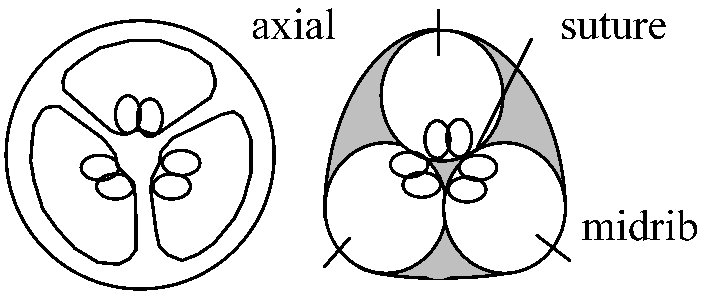 |
3) Free-central (and basal) placentation (特立中央胎座)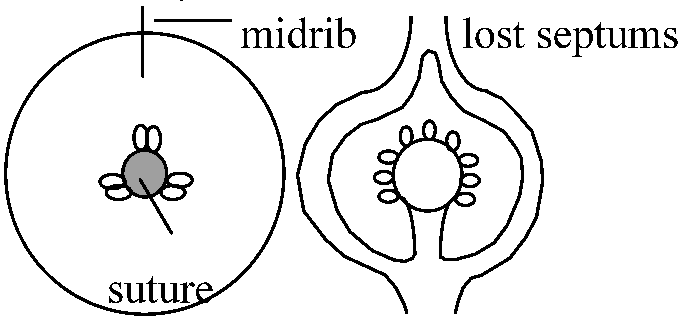 
Fig. 7.5. Heterostyly in Lythrum salicaria. Diagrams of the three forms of flowers, in their natural position, with petals and calyx removed on the near side. The dotted lines with the arrows show the directions in which pollen must be carried to each stigma to ensure full fertility (Darwin 1877). |
|
corolla (花冠): all of petals on a flower
Petal (花弁): modified leaves surrounding the reproductive organs
primitive angiosperms = low continuous spiral → Symmetry (相称性, 対称性)↔ asymmetry (非相称性), adj. asymmetric ↔ symmetric)1. radial symmetry (放射相称, 放射整正)
symmetrical plane ≥ 2
→ actinomorphic flower (放射相称花) symmetrical plane = 1 → stereoscopic a. median zygomorphy (中央左右相称)b. transversal zygomorphy (横断相称) c. oblique zygomorphy (斜面相称)
flower: near - front ⇔ far - back / leaf: near - up ⇔ far - down |
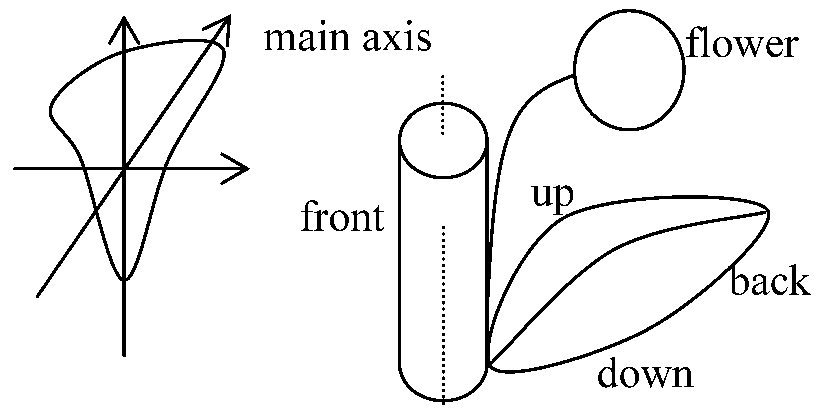

Terms for corolla morphology: rotate, cup-shaped, funnel-shaped (infundibuliform) (Ipomoea nil), campanulate (Enkianthus campanulatus), urceolate, calceolate, labiate (cf. bilabiate), personate, cruciate, hypocrateiform (Clerodendrum trichotomum), liliaceous, rosaceous, galeate, caryophylleous, irregular |
|
A method of recording floral structure, in particular, configuration of floral organs, expressed by a series of symbols, letters, and numbers Abbreviations
Ca (or K), calyx or whorl of sepals |
n,number of organs
Ca3, three sepals Keys╰╯: basally fused or connate ╭╮: apically fused or connate |
♂: male unisexual flower ♀: female unisexual flower ⚥: hermaphrodite bisexual flowers *: staminode; a sterile stamen G: ovary inferior to insertion point of the other whorls. The floral whorls are epigynous to the gynoecium G: ovary superior to insertion point of other floral whorls. The floral whorls are hypogenous to the gynoecium G: ovary inferior to superior, with variations |
Floral diagram (花式図)A stylized representation of flower structure in which the whorls of floral parts are shown as a series of concentric circles. All floral segments arising at the same level are placed, in their correct relative positions, in the same circle. When appropriate, fusion of parts is also indicated. The ovary is represented in cross section in the center of the whorls. Floral diagram shown by Campanula medium. Black dashed line shows the cross-section. 1: position of the main axis, 2: cross-section through the lateral flower; 3: bracteole; 4: subtending bract.
Floral diagram shown by Campanula medium. Black dashed line shows the cross-section. 1: position of the main axis, 2: cross-section through the lateral flower; 3: bracteole; 4: subtending bract. |
Kerria japonica (L.) DC. [Rosaceae] Solanum nigrum L. [Solanaceae] Robinia pseudoacacia L. [Fabaceae] Leucanthemum vulgare [Asteraceae]
|
|
Def. the arrangement of flowers on a stem or floral axis
a single flower or a cluster of flowers organized in a specific pattern  A. Indeterminate inflorescences (無限花序)flowering from base to topSpike (穂状花序) an elongate, unbranched inflorescence with sessile flowers Raceme (総状花序) an elongate, unbranched inflorescence with pedicelled flowers Corymb (散房花序) a flat-topped raceme with elongate pedicels reaching the same level Umbel (傘形花序) a flat-topped or rounded inflorescence with the pedicels originating from a common point (determinate or indeterminate) Panicle (円錐花序) a branched raceme  Fig. Indeterminate inflorescences B. Determinate inflorescences (有限花序)flowering from top or middleUniflowered inflorescence (単頂花序) Dichasium (二出集散花序) Monochasium (単出集散花序) Rhipidium or fan-shaped cyme (扇形花序): not catergorized when rhipidium is merged with scorpioid cyme Scorpioid cyme (or cincinnus) (蠍形花序): a zig-zag cyme with branches developing alternately on opposite sides of the rachis Drepanium (鎌形花序) Helicoid cyme (or bostryx) (蝸形花序): a cyme in which the branches develop only on 1 side |
Glomerule (団散花序) Hypanthium (隠頭花序) Cincinnus 扇状集散花序(多出集散花序)  Fig. Determinate inflorescences C. Specific inflorescences Spadix (肉穂花序), including indefinite inflorescence: (small) flowers borne on a fleshy stem, e.g., Araceae (サトイモ科)
Spadix (肉穂花序), including indefinite inflorescence: (small) flowers borne on a fleshy stem, e.g., Araceae (サトイモ科)Catkin (ament, 尾状花序): cylindrical flower cluster (a spike), with inconspicuous or no petals Cyathium (杯状花序): a cup-shaped involucre enclosing an apetalous, pistillate flower surrounded by several staminate flowers, only Euphorbia |
[inner structure of leaf]
|
An organ of a vascular plant, as defined in botanical terms, and in particular in plant morphology Def. Foliage leaf (普通葉): an ordinary leaf of a plant (s.l.)
= blade + petiole + stipule  Fig. Morphology of a typical leaf |
Bract (苞) or bract leaf (苞葉)a leaf growing from the area just below a flower and sometimes different in shape and/or color from the main leavesadj. bracteate, bracteal) ⇔ ebracteate, bractless: not forming bracts Involucre (総苞)bracts appearing in a whorl subtending an inflorescenceadj. involucrate, involucral Involucral bract or scale (総苞片): one or more of the bracts surrounding the capitulum and forming the involucreBracteole (小包葉): a secondary bract subtending a flower within an inflorescence |
| Leaf shape (葉形) | |
|---|---|
  |
1: filiform (filamentous) 糸状, 2: subulate 針形, 3: linear 線形, 4: broad linear 広線形 (sword-shaped → uniformly wide 等幅), 5: lanceolate 披針形 (< linear-lanceolate 線状披針形 < narrow lanceolate 狭披針形 < lanceolate-oblong 長楕円状皮針形, elliptic-lanceolate 楕円状披針形), 6: oblanceolate 倒披針形, 7: oblong 長楕円形 (linear-oblong 線状長楕円形, oblong-elliptic 近長楕円形, oblong-ovate 長楕円状卵形, oblong-obovate 長楕円状倒卵形), 8: elliptic(al) 楕円形, 9: ovate 卵形 (oval 広卵形& harr; narrow-ovate 狭卵形, ovate-lanceolate 卵状披針形, ovate-oblanceolate 卵形倒披針形, ovate-triangular 卵状三角形), 10: obovate 倒卵形, 11: spathulate (spatulate) 篦形, 12: cordate 心形, 13: obcordate 倒心形, 14: rhombic 菱形, rhombate (rhomboid) 偏菱形, 15: rhombate-ovate (rhomboid-ovate) 菱状卵形, 16: orbicular, orbiculate 円形 (orbiculate-ovate 卵円形), 17: oblate, depressed orbicular 偏円形(平円形), 18: reniform 腎(臓)形, 19: deltoid 三角形 (obtriangular 倒三角形, deltate 鈍頭広三角形), 20: lunate 三日月形(半月状), 21 unequal 不等形, 22 falcate 鎌形(左右不整三日月形) (adj. sickle 鎌状に曲がった). [Supp.] semicircular 半円の Dimorphism (二型性) Dimorphic leaf (二型葉)
Fertile and infertile leaves: |
| Leaf margin (葉縁) | |
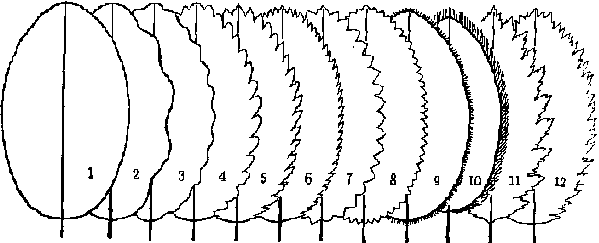
|
1 entire, 2 undulate, corrugated, 3 repand, 4 crenate, 5 serrate, 6 serrulate, 7 dentate, 8 denticulate, 9 ciliate, 10 fimbriate, 11 double serrate, 12 incised (Makino 1977) |
| Leaf base (葉基部) | |

|
1: attenuate (adj. cuspidate, pointed, acutish, blunt), 2: cuneate, 3: truncate (sub-), 4: obcordate (heart-shaped), 5: auriculate, 6: sagittate, 7: hastate (spear-shaped)* (*: used not only leaf shpae but also other organs) |
 |
1: petiolate. 2: sheathing. 3: sessile. 4: amplexicaular. 5: perfoliate. 6: decurrent. 7: connate-perifoliate. 8: pelate, shield-shaped |
|
One of a pair of lateral appendages, often leaflike, at the base of a leaf petiole in many plants
|
Pseudostipule (仮托葉): an often modified basal pair of leaflets of a compound leaf appearing very close to the stem, e.g., Artemisia indica |
= the stalk that attaches the leaf blade to the stem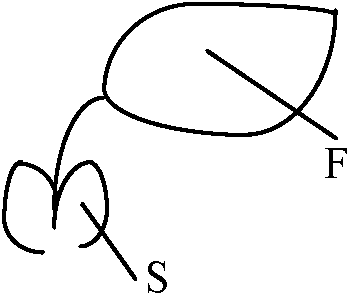 Maekawa hypothesis (1969)
Maekawa hypothesis (1969)
F: foliage leaf = F class leaf
|
Dicot.__________Monocot.
|
|
≡ one of the vascular bundles or ribs that form the branching framework of conducting and supporting tissues in a leaf or other expanded plant organ
Venule or veinlet (小葉脈): a small or secondary vein nunmber of veins (NV, 中軸分岐数)
|
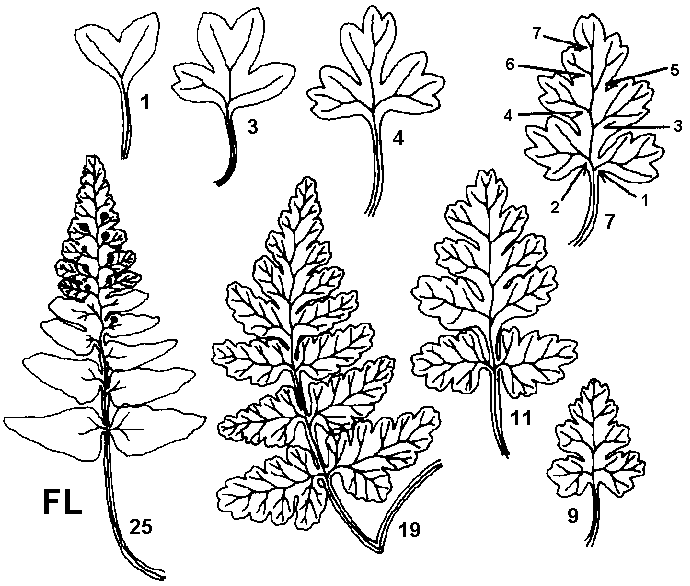 Fig. 1. Schematic representation of the leaf development of Dryopteris saxifraga. Number indicates the number of veins on each leaf. Arrows with number indicate the counting method of number of veins. FL, a fertile leaf with sporangia. (Sato 1985) |
|
Several indeces have been proposed to quantitatively express leaf shapes
Aspect ratio (horizontal to vertical ratio) = L/W
L: leaf length
l: leaf marginal length |
[ anatomy | measurement | root generation ]
Belowground system ≈ Root systemThree types of root systemsRhizoshpere: areas that are directly influenced by root activities
Tree: secondary growth (auxetic growth) Dicotyledons (and gymnosperms): main root (taproot, 主根/直根) + fine root 細根 (+ rootlet 支根) Fine root < φ 3-5 mm Monocotyledons: fibrous root + adventitious root (不定根): arising from an organ other than the rootnumerous on underground stems, such as rhizomes, corms and tubers - somtimes conducting vegetative propagation The roles of roots
 1 1
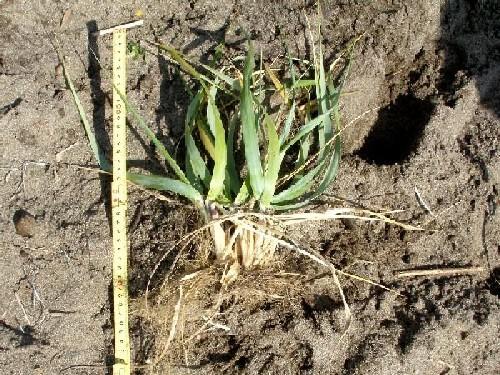 2 2
[1] Dicotyledons (Glehnia littoralis). [2] Monocotyledons (Elymus mollis). At a seacoast in Hakodate City on September 24 2009. → Root system of Carex kobomugi |
 Plant roots. A: taproot, B: fibrous root (髭根), C: adventitious root, D: adventitious roots of cuts (cut on left, cut with roots after a few weeks on right). MorphogenesisAerial root (気根): above-ground roots in the air
Functions: Parasitic root (寄生根): a root-like structure produced by a parasitic plant growing toward and attaching to a host plant, enabling the parasite to invade and extract resources Haustorium (寄生根/吸収根/吸器): specialized organ that penetrates the host tissues and connects to its vascular system ≈ tuberous root, e.g., sweet potato, cassava and dahlia Pneumatophore = respiratory or knee roots (通気根): usually partially exposed roots of a wetland plant, such as mangrove, that function in the intake of oxygen from the atmosphere |
(adj = hairy)
|
Trichome (トリコーム)Fine outgrowths or appendages on plants, e.g., hair, glandular hair, scale, and papilla.Papilla, pl. -ae (乳頭突起): the mere outgrowths of the epidermal cells that increasing the surface → protecting the stem against herbivores, relating to drought resistance Glandular hairs (腺毛): epidermal secretory structures Salt and chalk glands: typical structures of salt resistant plants Nectaries: present usually on entomophilous species, produce a sugary solution to attract the insects |
Gland (腺)functionally as a plant structure which secretes one or more productsoil spot (油点)
pale gland (明点) Hair on leaf and stem[Adjectives used for taxonomical description]
|